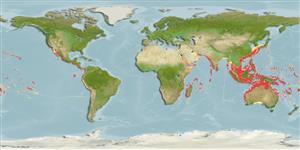Classification / Names
Common names from other countries
Main reference
Size / Weight / Age
Max length : 35.0 cm TL male/unsexed; (Ref. 3197); common length : 25.0 cm TL male/unsexed; (Ref. 9137)
Length at first maturity
Lm 17.6 range ? - ? cm
Environment
Marine; reef-associated; depth range 20 - 214 m (Ref. 58302), usually 30 - 70 m (Ref. 37816)
Climate / Range
Tropical, preferred ?; 39°N - 34°S, 180°W - 180°E
Distribution
Indo-Pacific and Southeast Atlantic: from Knysna to Natal, South Africa to Australia, including Persian Gulf and the Red Sea, and in the Central Pacific Islands from South Korea to Gulf of California to Peru, including Galapagos Islands (Ref. 9283). Distribution in south Western Australia, and South Australia is false.
Countries | FAO areas | Ecosystems | Occurrences | Introductions
Short description
Dorsal
spines
(total): 9;
Dorsal
soft rays
(total): 338;
Anal
spines: 3;
Anal
soft rays: 27 - 30. Body slender, elongate, and somewhat circular in cross section; posterior end of upper jaw concave dorsally and with a rounded protrusion ventrally; edge of shoulder girdle (cleithrum) with two small papillae, the lower one larger; dorsal and anal fin each followed by a separate finlet (Ref. 55763). Color metallic blue dorsally, silvery ventrally; fins hyaline; opercle with a small black spot (Ref. 2334). 24-40 scutes. Very slender compared to similar species (Ref. 48635).
IUCN Red List Status (Ref. 115185)
Threat to humans
Harmless
Human uses
Fisheries: commercial; bait: usually
Tools
Special reports
Download XML
Internet sources
Estimates of some properties based on models
Phylogenetic diversity index
PD50 = 0.5010 many relatives (e.g. carps) 0.5 - 2.0 few relatives (e.g. lungfishes)
Trophic Level
3.4 ±0.45 se; Based on food items.
Resilience
High, minimum population doubling time less than 15 months (K=0.50-1.60; Fec = 43,000)
Vulnerability
Low vulnerability (24 of 100)
Price category
